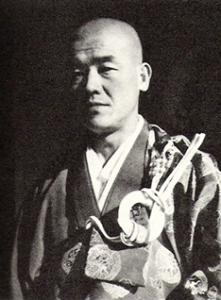It was on this day, the 11th of March, in 1984 that Rinzai Zen master Soen Nakagawa died at Ryutakuji monastery in Japan.
In my study of Zen come West, Zen Master Who? I wrote about him.
Through his regular visits, his Dharma heirs, and others he taught, Soen Nakagawa would become one of the most important figures shaping a Western understanding of Rinzai Zen. Soen Nakagawa was born (on the 19th of March,) 1907 in Iwakuni, near Hiroshima.
His father was an army doctor, and so the family relocated frequently. While Soen was still very young his father died. His mother, who never remarried, struggled to support the family. Eventually Soen was admitted to Tokyo Imperial University to study Japanese literature. He specialized in poetry, specifically Basho, perhaps Japan’s most beloved poet. Basho had studied as a Zen monk, and while he may have never been formally ordained, the Zen spirit clearly pervades his work.
Fascinated by the idea of the literary monk, Soen Nakagawa determined to ordain. In 1931, a year after taking his degree, Soen was ordained an unsui by the Rinzai master Katsube Seigaku Roshi at Kogakuji. He spent considerable time in a mountain retreat at Daibosatsu Mountain in Yamanashi Prefecture.
At this time he published some poetry and diary entries in a magazine called Fujijn Koron, “Woman’s Review.” Nyogen Senzaki read these and in 1934 initiated what would become a lifelong correspondence and profound friendship. At about the same time, Soon Nakagawa met the renowned Genpo Yamamoto Roshi, the abbot of Ryutakuji.
Soen’s first book of poems, Shingan, “Coffin of Poems,” was published in 1936. This was followed by three more, the last being in 1985 (the year after his death). Continuing his penchant for deep personal practice, not long after being accepted as a student of Genpo Roshi, he returned to Daibosatsu for two years of solitary retreat. He then returned to Ryutakuji and more formal training. In 1950 he succeeded his teacher as master of this renowned training hall.
Senzaki Sensei thought Soen Nakagawa Roshi would be a perfect teacher for the West and spent years trying to lure him to North America. Soen Roshi first planned to come to America in 1941, but the War intervened. He arrived in the West for the first time in 1949, where he met Nyogen Senzaki, who arranged his first talk at the Los Angeles Theosophical Society.
In 1950, Soen Nakagawa returned to Ryutakuji. Upon Nyogen Senzaki’s suggestion, young Robert Aitken made his way there and began studying with him. The next year, Philip Kapleau would stay there for three months before going on to Sogaku Harada Roshi’s temple, Hosshingji. Of equal importance, Soen Roshi would visit the United States thirteen times, leading sesshin, intensive meditation retreats on both coasts and spending extensive time with many different students.
Sean Murphy in his One Bird, One Stone recounts the following:
Soen loved to walk around New York City. He’d stare at the lighted skyscrapers, at their tops, he claimed he saw Buddha figures in the lights. “Look at the Buddha,” he’d point, “Shining Buddha!” He’d fill the sleeves of his robes with nuts and berries from Central Park or herbs growing in the sidewalk cracks, and add them to his bowl at the next meal. He loved the musical Fiddler on the Roof, and when asked a question about why some particular point of ceremony needed to be performed in a certain way, he might burst into song, responding “Tradition…!”
Soen was a creative teacher. Famously, he was known to conduct tea ceremony using Coca-Cola or instant coffee and occasionally using Styrofoam cups. Nothing was off limits if it would hep point the way. The wrier and (later) Zen teacher Peter Matthiessen’s 1975 journal recorded in Endless Vow: The Zen Path of Soen Nakagawa describes his experience with this remarkable teacher:
Cleaning the Zendo after evening sitting, I find Soen alone in the shadows at the end of the empty row, in the stillness of zazen. He is the archetypal old monk of the paintings, ancient as death, burning with life. I dust around him. These days his joy in life is dear; he refers gleefully to “the majority,” as he calls the dead… Each day he reminds us that, despite all the tumult and delusion of our life, our true nature is always there, like the sun or moon above black wind and clouds. “The sun is shining; the sun is always shining. That sun is enlightenment; everything is enlightenment!” He dabbled his fingers in a water bowl, “Do you hear? That is enlightenment!“
Apparently, in 1967 while trying to climb a tree, Soen fell and sustained a severe head injury. From that point on, Soen Roshi suffered from continuous pain and occasional bouts of depression. Following his retirement as abbot of Ryutakuji, he spent increasing amounts of time in solitary retreat. Whether this inclination wa connected with the pain he suffered, with depression, or simply with ever deepening practice is unknown. He died in 1984 – and his deaht poem summarizes an authentic Zen life.
Mustard blossoms!
There is nothing left
to hurl away.
Soen Nakagawak Roshi’s influence in the West and North America is substantive…
Half his ashes are interred at Ryutakuji, half in America.
As a special treat a series of talks touching on the life and teachings of Soen Nakagakwa by the remarkable American Zen teacher Roshi Mitra Bishop.
The ripples playing out form his life continue to wash across the West.













